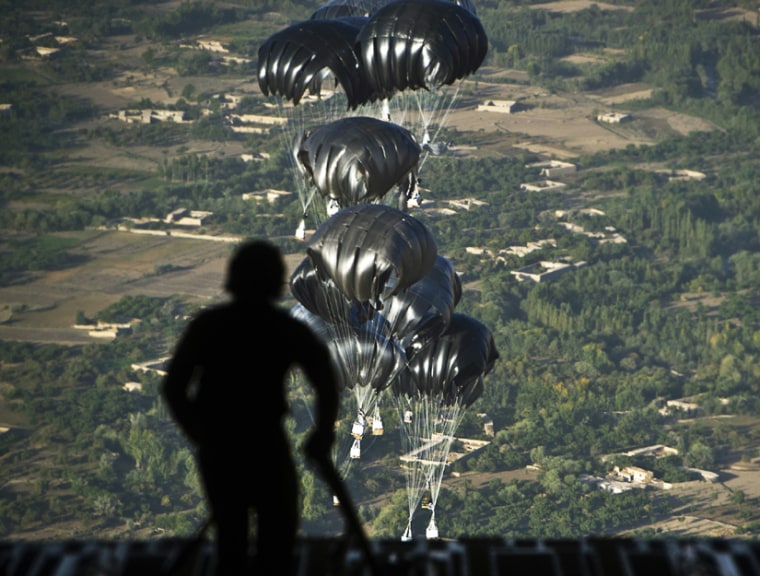As the U.S. military responds to more and more earthquakes, hurricanes and other natural disasters across the globe, it is finding that getting food and medicine to the right people and the right place isn't so easy.
Air drops go off-course, stuff lands in enemy territory and heavy piles of food or water injure (and sometimes kill) crowds below.
Recently, the military looked outside for help, putting out an engineering challenge that drew more than 1,100 entries on a web-based crowd-sourcing contest.
Among the winning solutions: An automated conveyor belt that launches gear out the back of a cargo plane and receives real-time data about wind speed, terrain and drop locations. As humanitarian cargo rolls out the back of the aircraft, webbing prevents it from blowing back inside by the vortex created by the airplane’s tail.
A second solution — by a Dutch aid worker — is also being considered. It uses rollers and a special chute to eliminate pallets, the heavy wooden platforms that sometimes land on people waiting for help on the ground.
The U.S. Air Force has been working on air drop issues for years, building sophisticated sensors to figure out how best to distribute material. They tried all kind of ideas, including remote-controlled parachutes and other electronic devices to direct aid drops.
"What we wanted to do is sit back and say I've seen the Golden Knights (Army parachute team) jump out of a helicopter and land on a dime, what could we do to get that kind of precision," said David Shahady, a deputy at the Air Force Research Laboratory's rapid reaction and innovation group at Wright-Patterson Air Force Base.
Now they're trying the ideas from the outside — building prototypes of both winning delivery systems. The goal is to find lower-cost solutions from experts and non-experts outside the military.
"We get a lot of DOD experts that give us advanced solutions," said David Shahady, a deputy at the Air Force Research Laboratory's rapid reaction and innovation group at Wright-Patterson Air Force Base. "But there are folks out there that you wouldn't think have a solution. Even if it's not perfect, it might spark us."
Shahady said the conveyor belt solution — as proposed by an Indonesian engineer — is something a lot simpler: the automated belt could be programmed to drop at just the right time — with weather and ground conditions all factored in.
The Pentagon has embraced crowd-sourcing recently, challenging the public to figure out how to wargame a way to defeat Somali pirates, carry injured Special Forces units through rugged enemy territory or invent better gloves for troops sliding down new synthetic ropes.
The advantage to crowd-sourcing competitions is they cost very little to run compared to grant-making, and only the best solutions get a financial reward, according to Dwayne Spradling, chief executive officer of InnoCentive, the firm that developed the web-based crowd-sourcing methodology for the Air Force.
"Organizations say they spent $100,000 to a $1 million solving this problem," Spradling said from his Boston office. "This is a fraction of that. We’re bringing solutions out in 90 days and I'm only paying for the solution."
Last year, InnoCentive worked with NASA to figure out a better way to protect satellites from solar flares. The winning entry came from a retired engineer and ham radio operator who had noticed certain frequency patterns that occur during solar events and developed a mathematical model to protect them.
His answer helped NASA up its lead time on these events from four to eight hours, protecting satellites and astronauts aboard the International Space Station.
The company also works with drug manufacturers and medical firms to design new medicines. Spradling said a diversity in thought processes is key in crowd-sourcing challenges.
"We're not trying to get the biochemistry problem to the biochemistry folks," Spradling said. "We're looking for physicists or construction workers to solve the problem."
